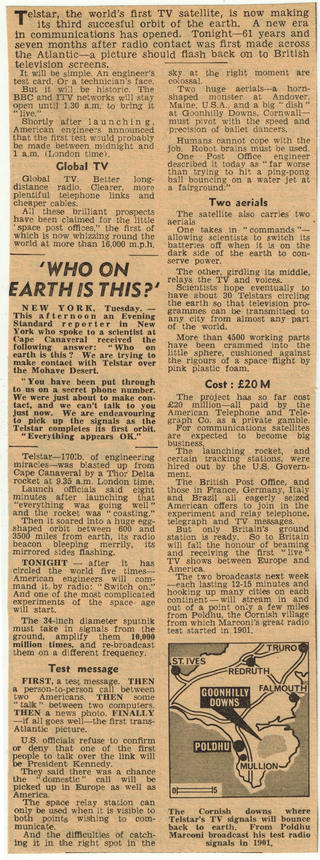Scrapbook 3: Telstar making its third successful orbit

Telstar, the world’s first TV satellite, is now making its third succesful orbit of the earth. A new era in communications has opened. Tonight—61 years and seven months after radio contact was first made across the Atlantic—a picture should flash back on to British television screens.
It will be simple. An engineer’s test card. Or a technician’s face. But it will be historic. The BBC and ITV networks will stay open until 1.30 a.m. to bring it “live.”
Shortly after launching, American engineers announced that the first test would probably be made between midnight and 1 a.m. (London time).
Global TV
Global TV. Better long-distance radio. Clearer, more plentiful telephone links and cheaper cables.
All these brilliant prospects have been claimed for the little “space post offices,” the first of which is now whizzing round the world at more than 16,000 m.p.h.
Telstar—170lb. of engineering miracles—was blasted up from Cape Canaveral by a Thor Delta rocket at 9.35 a.m. London time.
Launch officials said eight minutes after launching that “everything was going well” and the rocket was “coasting.”
Then it soared into a huge egg-shaped orbit between 600 and 3500 miles from earth, its radio beacon bleeping merrily, its mirrored sides flashing.
TONIGHT—after it has circled the world five times—American engineers will command it by radio: “Switch on.” And one of the most complicated experiments of the space age will start.
The 34-inch diameter sputnik must take in signals from the ground, amplify them 10,000 million times, and re-broadcast them on a different frequency.
Test message
FIRST, a test message. THEN a person-to-person call between two Americans. THEN some “talk” between two computers. THEN a news photo. FINALLY—if all goes well—the first trans-Atlantic picture.
U.S. officials refuse to confirm or deny that one of the first people to talk over the link will be President Kennedy.
They said there was a chance the “domestic” call will be picked up in Europe as well as America.
The space relay station can only be used when it is visible to both points wishing to communicate.
And the difficulties of catching it in the right spot in the sky at the right moment are colossal.
Two huge aerials—a horn-shaped monster at Andover, Maine, U.S.A., and a big “dish” at Goonhilly Downs, Cornwall—must pivot with the speed and precision of ballet dancers.
Humans cannot cope with the job. Robot brains must be used.
One Post Office engineer described it today as “far worse than trying to hit a ping-pong ball bouncing on a water jet at a fairground.”
Two aerials
The satellite also carries two aerials
One takes in “commands”—allowing scientists to switch its batteries off when it is on the dark side of the earth to conserve power.
The other, girdling its middle, relays the TV and voices.
Scientists hope eventually to have about 30 Telstars circling the earth so that television programmes can be transmitted to any city from almost any part of the world.
More than 4500 working parts have been crammed into the little sphere, cushioned against the rigours of a space flight by pink plastic foam.
Cost: £20 M
The project has so far cost £20 million—all paid by the American Telephone and Telegraph Co. as a private gamble.
For communications satellites are expected to become big business.
The launching rocket, and certain tracking stations, were hired out by the U.S. Government.
The British Post Office, and those in France, Germany, Italy and Brazil all eagerly seized American offers to join in the experiment and relay telephone, telegraph and TV messages.
But only Britain’s ground station is ready. So to Britain will fall the honour of beaming and receiving the first “live” TV shows between Europe and America.
The two broadcasts next week—each lasting 12-15 minutes and hooking up many cities on each continent—will stream in and out of a point only a few miles from Poldhu, the Cornish village from which Marconi’s great radio test started in 1901.
The Cornish downs where Telstar’s TV signals will bounce back to earth. From Poldhu Marconi broadcast his test radio signals in 1901.
‘WHO ON EARTH IS THIS?’
NEW YORK, Tuesday.—This afternoon an Evening Standard reporter in New York who spoke to a scientist at Cape Canaveral received the following answer: “Who on earth is this? We are trying to make contact with Telstar over the Mohave Desert.
“You have been put through to us on a secret phone number. We were just about to make contact, and we can’t talk to you just now. We are endeavouring to pick up the signals as the Telstar completes its first orbit. Everything appears OK.”